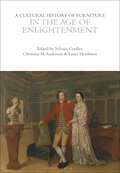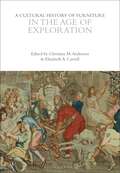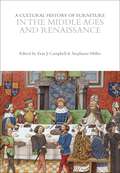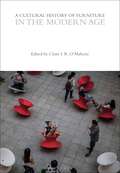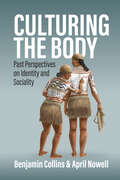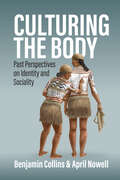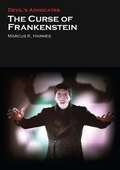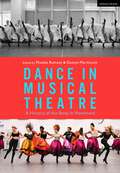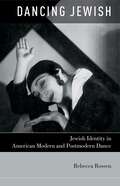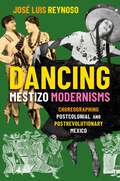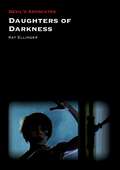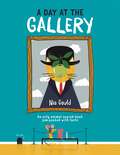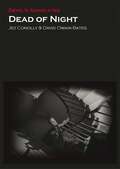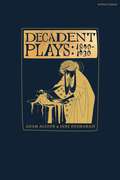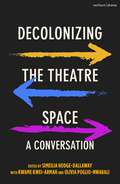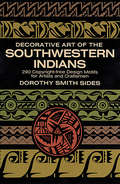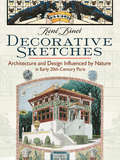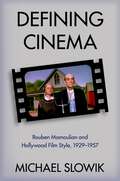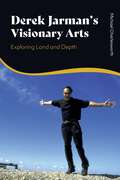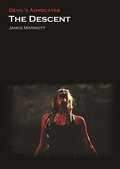- Table View
- List View
A Cultural History of Furniture in the Age of Enlightenment (The Cultural Histories Series)
The 18th century saw the height of court culture in Europe as well as the beginnings of its demise with conflicts such as the American and French Revolutions. The Scientific Revolution, which had begun in the preceding centuries, also ushered in a new intellectual era which advocated the use of reason to effect change in government and to advance progress in society. For furniture, this meant ever-higher standards of luxury in the designs, techniques and materials utilized for the best pieces, and more structure and specialization in the furniture-making process itself. Furniture also came into its own during this period as a collectable work of art on its own merits.Drawing upon a wealth of visual and textual sources, this volume presents essays that examine key characteristics of the furniture of the period on the themes of Design and Motifs; Makers, Making, and Materials; Types and Uses; The Domestic Setting; The Public Setting; Exhibition and Display; Furniture and Architecture; Visual Representations; and Verbal Representations.
A Cultural History of Furniture in the Age of Exploration (The Cultural Histories Series)
by Professor Megan AldrichThe 16th and 17th centuries in Europe witnessed a significant paradigm shift. Rooted in medieval beliefs and preoccupations, the exploration so characteristic of the period stemmed from religious motives but came to be propelled by commerce and curiosity as Europeans increasingly engaged with the rest of the world. Interiors in both public and private spaces changed to reflect these cultural encounters and, with them, the furniture with which they were populated. Visually, furniture of this period displayed new designs, forms and materials. In its uses, it also mirrored developments in science, technology, government and social relationships as prints became more widely distributed, the Wunderkammer developed and there was religious strife and resistance to absolute monarchical rule.Drawing upon a wealth of visual and textual sources, this volume presents essays that examine key characteristics of the furniture of the period on the themes of Design and Motifs; Makers, Making, and Materials; Types and Uses; The Domestic Setting; The Public Setting; Exhibition and Display; Furniture and Architecture; Visual Representations; and Verbal Representations.
A Cultural History of Furniture in the Middle Ages and Renaissance (The Cultural Histories Series)
The Middle Ages were marked by dramatic social, economic, political, and religious changes. Diverse regional and local conditions, and varied social classes - including peasant, artisan, merchant, clergy, nobility, and rulers - resulted in differing needs for furniture. The social settings for furniture included official and private residences both grand and humble, churches and monasteries, and civic institutions, including places of governance and learning, such as municipal halls, guild halls, and colleges. This volume explores how furniture contributed to the social fabric within these varied spaces.The chronological range of this volume extends from the fall of the Roman Empire through to the early Renaissance, a period which exhibited a wide array of types, styles, and motifs, including Byzantine, Romanesque, Gothic, and Renaissance. Rural and regional styles of furniture are also considered, as well as techniques of furniture manufacture. Drawing upon a wealth of visual and textual sources, this volume presents essays that examine key characteristics of the furniture of the period on the themes of Design and Motifs; Makers, Making, and Materials; Types and Uses; The Domestic Setting; The Public Setting; Exhibition and Display; Furniture and Architecture; Visual Representations; and Verbal Representations.
A Cultural History of Furniture in the Modern Age (The Cultural Histories Series)
Furniture is a unique witness to the transformations of private and public experience amidst the upheavals of the 20th century. How we work, rest and play are determined by the embodied encounter with furniture, defining and projecting a sense of identity and status, responding to and exemplifying contrasting social conditions, political and economic motivations, aesthetic predilections and debates. Assessing physical and archival evidence drawn from a spectrum of iconic and under-represented case studies, an international team of design historians collaborate in this volume to explore key methodological questions about how the production, consumption and mediation of furniture reveal shifting cultural habits and histories across diverse contexts amidst modernity. Drawing upon a wealth of visual and textual sources, this volume presents essays that examine key characteristics of the furniture of the period on the themes of Design and Motifs; Makers, Making, and Materials; Types and Uses; The Domestic Setting; The Public Setting; Exhibition and Display; Furniture and Architecture; Visual Representations; and Verbal Representations.
Culturing the Body: Past Perspectives on Identity and Sociality
The human body is both the site of lived experiences and a means of communicating those experiences to a diverse audience. Hominins have been culturing their bodies, that is adding social and cultural meaning through the use pigments and objects, for over 100,000 years. There is archaeological evidence for practices of adornment of the body by late Pleistocene and early Holocene hominins, including personal ornaments, clothing, hairstyles, body painting, and tattoos. These practices have been variously interpreted to reflect differences such as gender, status, and ethnicity, to attract or intimidate others, and as indices of a symbolically mediated self and personal identity. These studies contribute to a novel and growing body of evidence for diversity of cultural expression in the past, something that is a hallmark of human cultures today.
Culturing the Body: Past Perspectives on Identity and Sociality
by Benjamin Collins April NowellThe human body is both the site of lived experiences and a means of communicating those experiences to a diverse audience. Hominins have been culturing their bodies, that is adding social and cultural meaning through the use pigments and objects, for over 100,000 years. There is archaeological evidence for practices of adornment of the body by late Pleistocene and early Holocene hominins, including personal ornaments, clothing, hairstyles, body painting, and tattoos. These practices have been variously interpreted to reflect differences such as gender, status, and ethnicity, to attract or intimidate others, and as indices of a symbolically mediated self and personal identity. These studies contribute to a novel and growing body of evidence for diversity of cultural expression in the past, something that is a hallmark of human cultures today.
Curating Transcultural Spaces: Perspectives on Postcolonial Conflicts in Museum Culture (Visual Cultures and German Contexts)
Curating Transcultural Spaces asks what a museum which enables the presentation of multiple perspectives might look like. Can identity be global and local at the same time? How may one curate dual identity? More broadly, what is the link between the arts and processes of identity construction? This volume, an indispensable source for the process of engaging with colonial history in Germany and beyond, takes its starting point from the 'scandal' of the Humboldt Forum. The transfer of German state collections from the Ethnological Museum and the Museum for Asian Art, located at the margins of Berlin in Dahlem, into the centre of Germany's capital indicates the nation's aspiration of purported multiculturalism and cosmopolitanism; yet the project's resurrection of the site's former Prussian city palace, which was demolished during the GDR, stands in opposition to its very mission, given that the Prussian rulers benefited from colonial exploitation. By examining the contrasting successes of other projects, such as the National Museum of African American History and Culture in Washington DC, Curating Transcultural Spaces compellingly argues for the necessity of taking post-colonial thinking on board in the construction of museum spaces in order to generate genuine exchange between multiple perspectives.
The Curse of Frankenstein (Devil's Advocates)
by Marcus HarmesCritics abhorred it, audiences loved it, and Hammer executives where thrilled with the box office returns: The Curse of Frankenstein was big business. The 1957 film is the first to bring together in a horror movie the 'unholy two', Christopher Lee and Peter Cushing, together with the Hammer company, and director Terence Fisher, combinations now legendary among horror fans. In his Devil's Advocate, Marcus Harmes goes back to where the Hammer horror production started, looking at the film from a variety of perspectives: as a loose literaryadaptation of Mary Shelley's novel; as a film that had, for legal reasons, to avoid adapting from James Whale's 1931 film for Universal Pictures; and as one which found immediate sources of inspiration in the Gainsborough bodice rippers of the 1940s and the poverty row horrors of the 1950s. Later Hammer horrors may have consolidated the reputation of the company and the stars, but these works had their starting point in the creative and commercial choices made by the team behind The Curse of Frankenstein. In the film sparks fly, new life is created and horrors unleashed but the film itself was a jolt to 1950s cinema going that has never been entirely surpassed.
Dada 1916 in Theory: Practices of Critical Resistance (Value: Art: Politics #10)
by Dafydd JonesDada formed in 1916, embedded in a world of rational appearances that belied a raging confusion – in the middle of the First World War, in the neutral centre of a warring continent, fundamentally at the heart of Western art. This book sets out new coordinates in revision of a formation that Western art history routinely exhausts through its characterisation as a ‘revolutionary movement’ of anarchic cultural dissent, and does so in order to contest the perpetuated assumptions about Dada that underlie the popular myth. Dada is difficult and the response to it is not easy, and what emerge from the theoretical readings developed here are profoundly rational bases to the Dada non-sense that pitted itself against its civilised age, critically and implicitly to propose that Dada courses as vitally today as it did in 1916. The Zurich Dada formation initiated deliberate and strategic cultural engagements that struggled then, as they do now, to cohere in any sense as a ‘movement’, extreme in their ranges as diametrically hostile oppositionalities. Dada may be given art historically as identifiable along a trajectory of sustained ruptures and seizures, but it confounds all attempts at defined or definitive readings. This book duly offers not a history of Dada in Zurich but theoretical engagements of the emergencies and now the residue of the years 1916–19 – from ‘lautgedichte’ to laughter, masks to manifestos, chance to chiasmata – rounding to the ‘permanent’ Dada by which the formation ultimately breaks the containment and deep peace of art historical chronology.
Dance in Musical Theatre: A History of the Body in Movement
From Oklahoma! and West Side Story, to Spring Awakening and Hamilton, dance remains one of the most important and key factors in musical theatre. Through the integration of song and dance in the 'dream ballets' of choreographers like Agnes De Mille; the triple threat performances of Jerome Robbins' dancers; the signature style creation by choreographers like Bob Fosse with dancers like Gwen Verdon; and the contemporary, identity-driven work of choreographers like Camille A. Brown, the history of the body in movement is one that begs study and appreciation. Dance in Musical Theatre offers guidelines in how to read this movement by analyzing it in terms of composition and movement vocabulary whilst simultaneously situating it both historically and critically. This collection provides the tools, terms, history, and movement theory for reading, interpreting, and centralizing a discussion of dance in musical theatre, importantly, with added emphasis on women and artists of color. Bringing together musical theatre and dance scholars, choreographers and practitioners, this edited collection highlights musical theatre case studies that employ dance in a dramaturgically essential manner, tracking the emergence of the dancer as a key figure in the genre, and connecting the contributions to past and present choreographers. This collection foregrounds the work of the ensemble, incorporating firsthand and autoethnographic accounts that intersect with historical and cultural contexts. Through a selection of essays, this volume conceptualizes the function of dance in musical: how it functions diegetically as a part of the story or non-diegetically as an amplification of emotion, as well as how the dancing body works to reveal character psychology by expressing an unspoken aspect of the libretto, embodying emotions or ideas through metaphor or abstraction.Dance in Musical Theatre makes dance language accessible for instructors, students, and musical theatre enthusiasts, providing the tools to critically engage with the work of important choreographers and dancers from the beginning of the 20th century to today.
Dancing Mestizo Modernisms: Choreographing Postcolonial and Postrevolutionary Mexico
by Jose Luis ReynosoThis book analyzes how national and international dancers contributed to developing Mexico's cultural politics and notions of the nation at different historical moments. It emphasizes how dancers and other moving bodies resisted and reproduced racial and social hierarchies stemming from colonial Mexico (1521-1821). Relying on extensive archival research, choreography as an analytical methodology, and theories of race, dance, and performance studies, author Jose Reynoso examines how dance and other forms of embodiment participated in Mexico's formation after the Mexican War of Independence (1821-1876), the Porfirian dictatorship (1876-1911), and postrevolutionary Mexico (1919-1940). In so doing, the book analyzes how underlying colonial logics continued to influence relationships amongst dancers, other artists, government officials, critics, and audiences of different backgrounds as they refashioned their racial, social, cultural, and national identities. The book proposes and develops two main concepts that explore these mutually formative interactions among such diverse people: embodied mestizo modernisms and transnational nationalisms. 'Embodied mestizo modernisms' refers to combinations of indigenous, folkloric, ballet, and modern dance practices in works choreographed by national and international dancers with different racial and social backgrounds. The book contends that these mestizo modernist dance practices challenged assumptions about racial neutrality with which whiteness historically established its ostensible supremacy in constructing Mexico's 'transnational nationalisms'. This argument holds that notions of the nation-state and national identities are not produced exclusively by a nation's natives but also by historical transnational forces and (dancing) bodies whose influences shape local politics, economic interests, and artistic practices.
Daring Adaptations, Creative Failures and Experimental Performances in Iberian Theatre (Contemporary Hispanic and Lusophone Cultures #26)
In this volume, we are particularly interested in approaching theatre and performance as a dynamic and evolving practice of continuous change, regeneration and cultural mobility. Neither the dramatic texts nor their stage versions should be viewed as finished products but as creative processes in the making. Their richness lies in their unfinished and never-ending potential energy and their openness to constant revision, rehearsal, revival, and collective enterprise. This edited collection aims to create a dialogue on the artistic processes implicated in the various ways of working with the play text, the staging practices, the way audiences and critical reception can impact a production, and the many lives of Iberian theatre beyond the page or the stage. That is, its cultural and social legacies.
Daughters of Darkness (Devil's Advocates)
by Kat EllingerDaughters of Darkness (1971) is a vampire film like no other. Heralded as psychological high-Gothic cinema, loved for its art-house and erotic flavors, Harry Kümel's 1971 cult classic is unwrapped in intricate detail by writer Kat Ellinger to unravel the many mysteries surrounding just what makes it so appealing. This book, as part of the Devil’s Advocates series, examines the film in the context of its peers and contemporaries, in order to argue its place an important evolutionary link in the chain of female vampire cinema. The text also explores the film's association with fairy tales, the Gothic genre, and fantastic tradition, as well as delving into aspects of the legend of Countess Bathory, traditional vampire lore, and much more. The book contains new and exclusive interviews with director Harry Kümel and actress and star Danielle Ouimet.
Dawn of the Dead (Devil's Advocates)
by Jon TowlsonGeorge A. Romero’s Dawn of the Dead (1978) is celebrated both as a ‘splatter’ movie and as a satire of 1970s consumerism. One of the most financially successful independent films ever produced, Dawn of the Dead presented a strong vision to audiences of the time in terms of its excessive, often shocking violence. It challenged censorship internationally and caused controversy in the United States and the UK. The film created problems with distributors because of its length and its graphic content; with the MPAA who awarded it an ‘X’ in America (a rating usually reserved for pornography); with the BBFC in the UK who completely recut it; and in various European territories where it was released in several versions. Arguably, excess is at the heart of Dawn of the Dead, integral to its meaning: not only in its scenes of gore, its in-your-face social satire and its gaudy pop-kitsch style but in the production history of the film itself. This Devil’s Advocate explores the various ways in which Romero took Dawn of the Dead into areas of extremity during its scripting, production and distribution; and the responses of industry, censorship bodies, reviewers and audiences of the time to the film’s excesses. Taking the approach of a micro-historical study, Jon Towlson offers a close analysis of the film’s production context to explore the cultural significance of Dawn of the Dead as a ‘rebel text’ and an example of oppositional cinema.
A Day at the Gallery: An arty animal search book jam-packed with facts
by Nia GouldThe mice are captivated by Matisse and the cats are exploring the Surrealists’ room ... what else is going on in the gallery? This quirky and creative search-and-find book takes children, room by room, through a wonderfully illustrated gallery, where an array of animals are enjoying everything from Impressionism and Surrealism to Pop Art and Cubism. Each room is filled with strange and astonishing works of art, with things for children to spot and information that introduces artists and art movements. There’s a cat in a bowler hat, a cheesy Matisse, and plenty more to capture children’s imaginations as they enter the gallery for the first taste of the beautiful world of art. Perfect for children aged 6 and up.
Dead of Night (Devil's Advocates)
by Jez Conolly David BatesReleased a matter of days after the end of the Second World War and a dozen years ahead of the first full-blooded Hammer Horror, the Ealing Studios horror anthology film Dead of Night featured contributions from some of the finest directors, writers and technicians ever to work in British film. Since its release it has become evermore widely regarded as a keystone in the architecture of horror cinema, both nationally and internationally, yet for a film that packs such a reputation this is the first time a single book has been dedicated to its analysis. Beginning with a brief plot précis 'road map' in order to aid navigation through the film's stories, there follows a discussion of Dead of Night's individual stories, including its frame tale ('Linking Narrative'), a consideration of the potency of stillness and the suspension of time as devices for eliciting goose bumps, an appraisal of the film in relation to the very English tradition of the festive ghost story, and an analysis of the British post-war male gender crisis embodied by a number of the film's protagonists. The book includes a selection of rarely seen pre-production designs produced by the film's acclaimed production designer, Michael Relph.
Decadent Plays: Salome; The Race of Leaves; The Orgy: A Dramatic Poem; Madame La Mort; Lilith; Ennoïa: A Triptych; The Black Maskers; La Gioconda; Ardiane and Barbe Bleue or, The Useless Deliverance; Kerria Japonica; The Dove
Poisoned cigars, seductive apparitions, minds and empires in the last of their decline and the most notorious kiss in dramatic history – decadent plays challenged the moral as much as the dramatic imagination of their own day, and continue to probe horizons of taste and the possibilities of stagecraft. In the late 19th and early 20th centuries, many writers reacted to urban modernity by embracing decadent themes and styles, and dramatists were no exception. Decadence offered these writers a framework for exploring nonconformist identities and beliefs that challenged behavioural norms as much as the desirability of modern progress. Decadent plays were at once behind the times in their celebration of antiquity, and forward-thinking in their staging of themes that have become all the more timely in the 21st century, including queerness, unconventional eroticism, and critiques of empire and industrial progress. Equally, the diversity of decadent drama cannot be pigeon-holed; many of these plays still have the capacity to offend worldviews, and invite us to interrogate present-day conventions and propriety. International in scope and eclectic in content, this edited anthology is an authoritative and accessible introduction to a fast-expanding field of decadent literature. The first publication of its kind to deal with decadent drama, and featuring plays translated into English for the first time, Decadent Plays: 1890 to 1930 breaks new ground by foregrounding decadence as a dramatic sensibility in this most pivotal of periods in the history of modern drama. Featuring canonical and little-known works by Oscar Wilde, Michael Field, Lesya Ukrainka, Rachilde, Remy de Gourmont, Jean Lorrain, Leonid Andreyev, Gabriele D'Annunzio, Maurice Maeterlinck, Izumi Kyoka, and Djuna Barnes, this anthology is an essential introduction to decadent drama that will pique the interest of specialists and non-specialists alike.
Decolonizing the Theatre Space: A Conversation
by Simeilia Hodge-Dallaway Kwame Kwei-Armah Olivia Poglio-Nwabali2020 was a year in which global politics radically shifted, catalyzed by the Covid-19 pandemic and the #BlackLivesMatter movement. This book is a response to that year, asking: was it a moment or is it a movement, and what fundamental changes within the arts industry need to come out of this time? The book includes over 20 interviews with some of the most pioneering Black cultural leaders from a wide range of senior executive positions in the arts within the UK, Europe, US and Africa. It documents the sea of change in arts leadership at the height of the #BlackLivesMatter movement, the pressure on organizations to confront and change their racial and ethnic make-up, and shines a light on the guiding ambitions, strategic plans and visions for the future to support the ongoing decolonization of arts organizations across the world. Learn from those who have walked the walk to support your vision for the future.
Decorative Art of the Southwestern Indians
by Dorothy S. SidesThe decorative art of the Indians of the American Southwest has long been recognized as one of the most beautiful art traditions in the primitive world. It demonstrates a technical skill with simple materials, a symbolic richness, and a faculty for creating rich effects by the imaginative use of ornament that are all almost unique. Museums use Pueblo ceramics for display pieces, and modern artists and crafters have turned eagerly to the handwork of prehistoric Indian women for inspiration and working ideas.Mrs. Dorothy Sides, a noted artist and collector, has gathered together and redrawn in black and white nearly 300 examples of the finest authentic Southwestern Indian decoration that she has seen in a lifetime of study. She has not limited her selection to one period or style, however; to make her book as useful as possible, she has selected material ranging from the thirteenth century great geometric art of the Pueblos to the handcrafts carried on by the nomadic and Pueblo peoples of the present.The main emphasis of this volume is on ceramic decoration, and Mrs. Sides includes pieces from the rich archeological sites of Pecos, Sikyatki, the Mimbres, and modern Pueblo pottery from Acoma, Zuni, Cochiti, and the Hopi. She also includes designs and motifs from the basketry of the Apache, Pima, and Papago; beadwork from the Mohave; authentic Zuni masks; Hopi kachina dolls; and sand paintings and blanket designs from the Navajo. This broad coverage of beautiful ornament illustrates many different art styles to fit every situation: geometric designs based upon balanced mirror fields of design, symbolic figures of the thunderbird, and modern stylizations. All is beautiful and imaginative.Any crafter working with ceramics will find this book indispensable as a source of rich, easily used, powerful design; workers in wood, weavers, metal workers, and leather workers will find that it will enlarge their decorative resources considerably. It also offers unusual and eye-catching designs for commercial artists who wish to do work suggesting travel, handcrafts, the Southwest, or the social sciences. Individual drawings are royalty-free and may be reproduced without fee or permission.
Decorative Sketches: Architecture and Design Influenced by Nature in Early 20th-Century Paris
by René BinetAt the turn of the 20th century, artists and craftsmen throughout Europe and America were profoundly affected by a new art style that took its inspiration from nature. Generally referred to as Art Nouveau, the trend influenced all manner of creative types, from painters, illustrators, and architects to ironworkers, interior decorators, and designers of furniture and jewelry. Although broad and varied, the style is almost uniformly characterized by abstract, asymmetrical, curvilinear design. This "new art" both elevated the status of crafts to fine arts and brought objects into a harmonious relationship with their environment through the use of lines that were natural, vital, and, most importantly, organic.The decorative images in this volume, reproduced from a rare 1902 portfolio, reflect the era's exotic and imaginative approach to architecture and applied design. Sixty plates, 12 in full color and many with partial and varied color, exhibit the influence of the artwork of naturalist Ernst Haeckel on artist René Binet's designs, especially as related to Binet's "Monumental Door," prepared for the 1900 World's Fair in Paris. Illustrations reflecting the styles of Art Nouveau include a wealth of examples that range from doorbells and keys to stairways, fountains, jewelry, ceramics, and other items. Graphic designers, illustrators, architects, artists, and crafters will find this volume a rich source of ornamental ideas, authentic motifs, and design inspiration.
Decorative Wrought Ironwork: Projects For Beginners (Dover Craft Books)
by Thomas F. GoogertyAn excellent introduction to the exciting world of ironwork, this easy-to-follow guide features dozens of simple, traditional plans for use by amateur craftspeople and students interested in metalworking. Articles in the collection have been selected for their simplicity, but some previous experience in at least a few of the more common, basic processes employed in forging metals is recommended.The manual contains everything metalsmiths and hobbyists could wish for, including precisely drawn-to-scale patterns, descriptive notes on the tools of the trade, and detailed instructions on the metalworking process. More than 45 illustrations provide clearly drawn designs for flowerpot holders and stands, ash trays, andirons, candlesticks, door latches and locks, hinges, lamps, door knockers, and other decorative domestic accessories. A rich source of information and inspiration, Decorative Wrought Ironwork Projects for Beginners invites hobbyists to choose from a remarkable variety of motifs that can be successfully fashioned with the help of working drawings and helpful notes on construction.
Defining Cinema: Rouben Mamoulian and Hollywood Film Style, 1929-1957 (Oxford Music / Media)
by Michael SlowikArriving in cinema when synchronized sound had just been adopted, director Rouben Mamoulian demonstrated key early methods for making sound aid storytelling, for giving films a crisper sense of rhythm, for creating musicals set in backstage, fairy-tale, and folk environments, for providing intricate and arresting colour palettes, and for rendering sexual content more palpable under industry censorship. Mamoulian also wrote many articles throughout his lifetime and gave interviews and lectures where he advanced his complex ideas about the potentials of various artforms, including cinema. In addition, he left an extensive paper record of his work, including heavily annotated scripts for each of the sixteen films he directed. Mamoulian also enjoyed major success on the stage. He directed the original landmark productions of Porgy, Porgy and Bess, Oklahoma!, and Carousel, and his efforts in this domain informed his film work. Defining Cinema takes a holistic look at Mamoulian's oeuvre by examining both his stage and his screen work, and also brings together insights from his correspondence, his theories on film, and analysis of the films themselves. It presents a filmmaker whose work was innovative and exciting, who pushed hard on cinema's potential as an artform, and who in many ways helped move cinema towards the kind of entertainment that it remains today. The book thus tells a story that is vital not just for better understanding the work of a neglected filmmaker, but for anyone interested in the history of Hollywood filmmaking.
Derek Jarman’s Visionary Arts: Exploring Land and Depth
by Michael CharlesworthDerek Jarman's place in the history of film is assured by virtue of his vibrant, defiant films that experiment with the very process of film-making and create new forms. His paintings, their excitements and their profundity, are less well known. Michael Charlesworth sheds light on the varied ramifications of Jarman's artistic practice from his years at Prospect Cottage, Dungeness, and provides the first book-length study of his interest in depth psychology. He draws on Jarman's paintings, especially his landscapes from the 1960s and 70s, his multiple series such as 'black' and 'broken glass', GBH, Queer and Evil Queen, and his last Ecstatic Landscapes (1991-3). He also showcases Jarman's excellence as a writer with respect to his memoir, Kicking the Pricks. In a novel approach to Jarman's cinema, selecting films such as Journey to Avebury (1973), Caravaggio (1986), The Garden (1990) and Blue (1993), Charlesworth emphasizes themes and artistry rather than narrative. Exploring the ways in which Jungian and post-Jungian psychology were absorbed into Jarman's varied works, Derek Jarman's Visionary Arts provides a fresh perspective on his painting, film and writing. It celebrates him as one of the major British artists of the late 20th century, engaging with current debates about queer sexualities, environmentalism and climate catastrophe.
The Descent (Devil's Advocates)
by James MarriottThe story of an all-female caving expedition gone horribly wrong, The Descent (2005) is arguably the best of the mid-2000s horror entries to return verve and intensity to the genre. Unlike its peers (Saw [2004], Hostel [2011], etc.), The Descent was both commercially and critically popular, providing a genuine version of what other films could only produce as pastiche. For Mark Kermode, writing in the Observer, it was "one of the best British horror films of recent years," and Derek Elley in Variety described it as "an object lesson in making a tightly-budgeted, no-star horror pic." Time Out's critic praised "this fiercely entertaining British horror movie;" while Rolling Stone's Peter Travers warned prospective viewers to "prepare to be scared senseless." Emphasizing female characters and camaraderie, The Descent is an ideal springboard for discussing underexplored horror themes: the genre's engagement with the lure of the archaic; the idea of birth as the foundational human trauma and its implications for horror film criticism; and the use of provisional worldviews, or "rubber realities," in horror.
